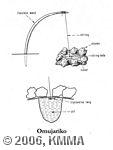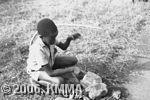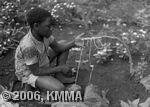




Other names: kitulege, ekitulege, sekitulege, ekitabiizire, rwakanengyere, kanyagombwa
The omujariko is a single-string ground bow with a hole in the ground for a resonator. A flexible twig measuring 130 to 150 cm in length is inserted into the ground and a string is attached to the top of the bow. A hole 20 cm wide and 25 cm deep is dug near the bow and is covered with a banana leaf, a tin sheet or other suitable material. A small hole is made in the centre of the cover and the string is pushed through it and fixed to a wooden peg that sits crossways across the small hole. The cover is placed over the dug-out hole and the bow is bent, which makes the string taut. Stones are put on the outer edges of the cover to keep it in place.
The player kneels or crouches down to the right of the instrument. The string is plucked with the stretched index finger of the right hand, acting as a plectrum. The player holds the top of the bow with his left hand and by pushing it down or stretching it he can change the pitch. Pushing down produces a lower note and pulling the bow up produces a higher note. This results in an ambitus of a quarter or even a fifth. The quivering string can be damped with the left hand.
The omujariko is mainly played by children as a kind of toy. The player usually sings and plays solo, for relaxation either for himself or others.
The omujariko is played all over Ankole, except by the Hima. The instrument is most popular with the Kunta and the Kooki.
for more information see also: VAN THIEL, Paul, "Multi-Tribal Music of Ankole. An ethnomusicological study including a glossary of musical terms." Edited by the Royal Museum for Central Africa, Annales, Sciences Humaines, nr 91, 1977, 234 pp.
© KMMA/Paul VAN THIEL